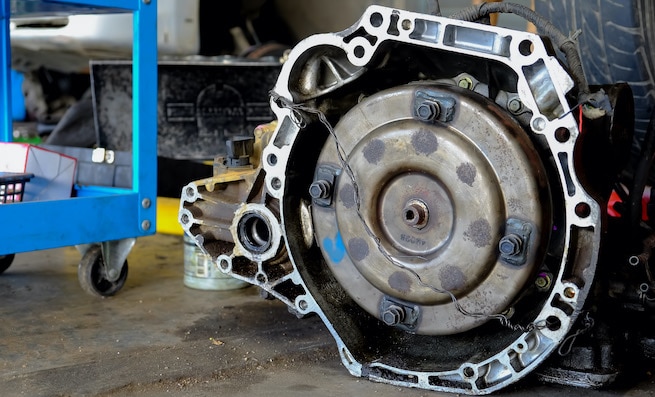10 Symptoms of Low Transmission Fluid And Replacement Cost
The transmission in our vehicles is one of the most complex components. It is typically hidden under, beside, or behind the engine, depending on the vehicle’s make and model. They can be very expensive to repair and even more costly to replace. Keep reading to learn the symptoms of low transmission fluid on a car.
The most common issue is low levels of automatic transmission fluid, which generate various symptoms. Erratic shifting, overheating, and grinding noises can cause damage to the car’s transmission and large repair bills for the owner.
Many drivers never check fluid levels or follow manufactures guidelines for maintenance of the transmission. This approach can lead to poor performance and large expenses. Fluid leaks can cause the transmission to be low on transmission fluid. Leaks can be caused by stones, leaking connections, and drain plugs not fully tightened.
The following article provides more information about these common symptoms and what drivers should look for if they suspect a transmission problem in their vehicle.
10 Most Common Low Transmission Fluid Symptoms To Watch
 There are many things that can lead to low levels of transmission fluid in your vehicle’s transmission. The following are symptoms that may indicate your transmission is running low on oil. Always follow up on these issues before doing further damage to the transmission, which could cost thousands of dollars for major repairs.
There are many things that can lead to low levels of transmission fluid in your vehicle’s transmission. The following are symptoms that may indicate your transmission is running low on oil. Always follow up on these issues before doing further damage to the transmission, which could cost thousands of dollars for major repairs.
1. Trouble shifting gears or “hard shifting”
A transmission relies on ATF fluid and hydraulic pressure to shift gears. Anytime the transmission is low on fluid, erratic shifting may occur. Sometimes the transmission will shift earlier or later than normal. It may slam into the next gear causing an audible bang.
These hard or erratic gear shifts are a sure sign your transmission is low on oil. Have it checked immediately and also whether there is a leak? If you notice transmission fluid under your vehicle after it has been parked, have a mechanic examine the transmissions for leaks.
2. Gear slippage or “transmission slipping”
Whenever your transmission slips back into the previous gear after making a gear change, it is called gear slippage. There may also be quick or sudden up or downshifts. Serious problems are indicated if you hear a grinding noise from the transmission.
This is another indicator of low transmission fluid. Vehicle transmissions can overheat under these circumstances, damaging friction materials on clutches and transmission bands further. Have your transmission checked immediately before catastrophic damage occurs.
3. Check engine light
The check engine light indicates there is a problem with your engine or transmission. Error trouble codes are generated and stored by the engine control module. These codes can be read using an electronic module used by all mechanics.
However, there is a good chance that if you are also experiencing transmission issues, the code was generated by the ECM and indicates there is a problem with the transmission. Don’t ignore the check engine light; it could indicate there is a serious problem with the engine or the transmission.
4. Delayed gear engagement
An automatic car transmission system needs sufficient transmission fluid to change gears quickly. Sluggish or slow gear changes usually indicate insufficient ATF fluid required to maintain pressure during a gear change.
Drivers with manual transmissions may also find it difficult to change gears if the manual transmission fluid is low. They may need to attempt to shift gears several times before being successful. Low fluid levels can also cause the transmission to overheat, potentially causing permanent damage to the transmission friction pads and bands.
5. Irregular gear shifting
Low transmission fluid can cause irregular gear shifting, either shifting too fast or too slow. The transmission system needs stable hydraulic pressure to operate as designed by the manufacturer.
Low levels of transmission fluid, combined with road conditions, can contribute to unstable pressure at times leading to irregular gear shifts. As more fluid is lost, this problem may become worse. For example, hard shifts, slow shifts, or not shifting at all and possible overheating of the transmission.
6. Transmission fluid leaks
Anytime there is a puddle of fluid under your vehicle, there is a leak and should be checked. Brake fluid, engine oil, coolant, and transmission fluids are the possible culprits. Check all fluid levels; however, if the coolant, brake, and engine oil levels are ok, then it is probably transmission fluid leaking onto the ground under your car.
Leaks can be caused by failed seals and gaskets, drain plugs that are loose or damaged to the transmission oil pan. Have a quick look under your car to check the location of the leak for added clues to the source of the leak. This is one of the most common signs of low transmission fluid a car can get.
7. Burning smell
In addition to providing hydraulic fluid pressure to shift gears, the transmission fluid also provides cooling to the transmission and reduces friction between various metal components. Overheating can occur if there is insufficient ATF transmission fluid in the system.
As friction increases between components of the transmission, they will overheat. Burned ATF fluid smells bad, and there could even be some smoke coming from the transmission. Drivers need to immediately pull over and allow the transmission to cool down before permanent damage occurs.
8. Overheating transmission
Transmissions can overheat due to low levels of transmission oil, pulling loads beyond the capacity of the transmission, and driving at high engine RPM in low gear. Drivers experiencing erratic gear changes or slow shifts should always check for low fluid levels and top up levels immediately.
Driving a vehicle with an overheated transmission for extended periods can severely damage the transmission. Arrange for a mechanic to check your transmission and add transmission fluid as needed. If there is permanent damage, you may notice erratic shifts or noises from the transmission, even with sufficient oil in the system.
9. Strange noises
Anytime drivers hear unusual noises coming from the transmission, there usually is a problem. Metal parts that are not sufficiently lubricated can make a grinding noise or hard clunks when shifting. Transmission usually makes very little noise. One of the first things to check is the level of transmission oil in the system.
Avoid driving your vehicle until the oil level has been verified and topped up if needed. Always use the proper transmission ATF fluid for your vehicle or have a mechanic add the system’s proper fluid.
10. Complete transmission failure
Sometimes drivers ignore all of the telltale signs that fluid levels are too low in the transmission. They ignore the unusual signs such as noise levels, slow or erratic gear shifting, and even the smell from an overheated transmission. A transmission can fail completely if driven too long under these conditions.
Drivers may find the car won’t move or only can drive it in a single gear. Transmission overheating can cause total failure and require an expensive transmission replacement. It is also related to the common signs of bad transmission on your car.
F.A.Q. When You Have Symptoms of Low Transmission Fluid
 Many drivers ignore signs of malfunction until major damage has been done to their vehicles. Anytime your vehicle is not operating normally, have the vehicle checked by a mechanic before further damage occurs. The following is a shortlist of frequently asked questions that can assist drivers to determine if they have a serious issue and what action they should consider.
Many drivers ignore signs of malfunction until major damage has been done to their vehicles. Anytime your vehicle is not operating normally, have the vehicle checked by a mechanic before further damage occurs. The following is a shortlist of frequently asked questions that can assist drivers to determine if they have a serious issue and what action they should consider.
What is the most common low transmission fluid symptom?
Normally this car part requires sufficient fluid to create pressure to change gears. When fluid levels are low, there is insufficient hydraulic pressure, and lubrication of the various components is less than optimal, which can cause overheating of the system.
Gear slippage may be the first indication that there is a low transmission fluid. As the additional fluid is lost, some of the other more severe indications will be present, leading to significant damage to this car part.
How often should I check the transmission fluid level?
Experts suggest checking the transmission fluid level every six months and more often if drivers suspect that there is a problem with this car part. Check your vehicle’s manual for how often it’s oil should be changed.
Anytime owners notice fluids on the ground under the engine area, check all fluid levels and top up the appropriate fluids. Never mix fluids. Significant damage can be caused by adding incorrect fluids.
Most vehicles have a dipstick for the transmission similar to the engine oil dipstick. Check your manual for location and proper maintenance recommendations.
What other signs of low transmission fluid should I look for?
There are potentially many signs your transmission fluid levels are low. We have listed a few of them in the following list:
- Gears are difficult to shift or won’t shift
- Gears slip into and out of proper gears
- Car transmission overheats
- Erratic transmission gear shifts
- Check engine light illuminates
- Noise from the transmission system
- Transmission gears will not shift
- Dar red fluid color indicates older fluid with lots of wear and tear
- Thicker fluid indicates contaminants
- Foamy fluid can indicate overfilling or the wrong fluid in the system
- A burnt smell can indicate overheating
- Complete failure of the transmission system
- Checking if the fluid is low regularly is important to prevent damage.
Replacement cost vs. Repair cost of low transmission fluid symptoms
Transmissions are one of the most complex components in modern vehicles. The transmission problems are also expensive to replace. The cost for replacement depends on the vehicle’s make and model, with prices ranging from $1800 to $3400 with additional labor charges from $500 to $1200.
Vehicle owners can also save money by installing a rebuilt transmission that may cost between $1100 to $2800. A used or salvaged transmission from another vehicle can be purchased from $800 to $1500; however, there is no warranty and no guarantee regarding the salvaged transmission condition.
Transmission repair costs can vary a great deal as well, depending on the transmission system’s condition. Transmission rebuilding costs can cost as much as purchasing a rebuilt transmission system. The best approach is to follow the manufacturer’s recommendations for regular maintenance. Check the transmission fluid levels every six months and change the fluid as recommended.
Summary
Drivers should check transmission fluid levels whenever they notice their vehicle’s transmission is not running smoothly or if there is fluid on the ground under the transmission. The above mentioned are common signs of low transmission fluid that are associated with transmission problems in a car.
Regular maintenance and fluid level checks can prevent many of the problems and transmission failures caused by a lack of fluid. Most likely the transmission light will come on whenever you get some of these transmissions problems. You might even have noticed that the gear is hard when you try to put you car in park.
Now you understand the main symptoms of low transmission fluid on your car. If you ever experience something similar now you know how much would be the amount it’s going to cost to get it fixed. Hope this article can help you save time.
Last Updated on: October 22, 2024

